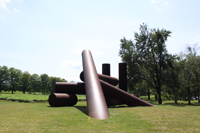| |
Click
to enlarge photo of
Adonai
, 1970 - 1971 by Alexander Liberman.
 |
The inspiration for Adonai came from Liberman’s visit to Chartes, one of the greatest medieval cathedrals in France. Adonai’s two vertical cylinders suggest an entrance portal and its long horizontal cylinder suggests a nave. The sculpture’s name, Adonai, is the Hebrew word for God.
|
Adonai is constructed using abandoned rusted underground storage tanks that Liberman purchased at auction as salvage. Adonai is one of only few of Liberman’s early works in which the components were used in their natural rusted state. Its cylindrical elements are cantilevered to suggest movement, particularly upward thrust. Liberman states, “I want the extreme thrust, or the extreme overhang, because I want to achieve a certain sense of awe. For dramatic impact you have to dominate the spectator. One of the ways of achieving this is by having great overhangs, effects that create wonder.”
"Alexander Liberman was born in 1912 in Kiev Russia. His father was in the timber business and his mother was involved in the Russian theater. In 1921 the Libermans left the Soviet Union, and Alexander studied first in London and then in Paris. He took courses in philosophy and mathematics at the Sorbonne and architecture at Ecole des Beaux-Arts. In the 1930s Liberman designed stage sets, worked briefly with a landscape architect. and worked on the staff of "Vu," the first magazine illustrated with photographs. Consequently, he became friends with Cartier Bresson, Brassai and Kertesz. Liberman began his publishing career as an assistant in the art department, moved on to become art director, then managing director. He even used a nom de plume to write their film reviews. In 1936 Liberman left the magazine and devoted himself to painting, writing and filmmaking.
"In 1940 the Liberman family escaped to the unoccupied zone in France, then to Spain, and eventually to New York in 1941. A friend helped him gain employment at VOGUE magazine and twenty years later, in 1962, he was appointed Editorial Director of all Conde Nast Publications, a position he held until he retired in 1994. During his long tenure at VOGUE, Liberman commissioned artists such as: Cornell, Dali, Chagall, Duchamp, Braque, Rauschenberg, Johns to work on projects for the magazine. He was the only publisher granted the rights to reproduce images of Matisse's chapel in Vence, France. He also had Jackson Pollock's paintings used as a backdrop for a fashion shoot by Cecil Beaton, as there was no other way to get Pollock's work reproduced in the magazine. Liberman's 'day job' offered him a highly unusual position in the art world.
"By the mid-1950s, Liberman was exhibiting his own paintings and photographs in galleries and museums around New York. In 1959 Liberman learned to weld steel and he quickly began making sculpture on a scale that required industrial machinery. By 1963 he had hired an assistant to do all of the grinding and labor required to make large sculpture. He embraced the industrial scale of America that had so impressed him on his arrival to here in 1941.
"One of his first public commissions was from the architect Philip Johnson for a pavilion at the 1963 World's Fair. Other important commissions quickly followed, and over the next decade he purchased additional equipment and hired additional personnel to meet the increasing demand for and scale of his sculpture.
"Alexander Liberman died in November, 1999 at the age of 87. His sculpture and painting are included in the collections of some of the world's most prestigious museums, such as the Metropolitan Museum in New York, the Museum of Modern Art, the Corcoran, Hirshhorn Museum & Sculpture Garden, the Solomon R. Guggenheim Museum, the Tate Gallery in London, and the Los Angeles County Museum of Art. In addition, Storm King Art Center, the most important contemporary sculpture park in America, has three monumental Liberman sculptures in it's collection. His public sculpture can be seen in over 40 cities around the world, including three that are located in Los Angeles."
Source:
Alexander Liberman at artscenecal.com
Location: Mountainville
|


 Storm King Art Center - Alexander Liberman
Storm King Art Center - Alexander Liberman



